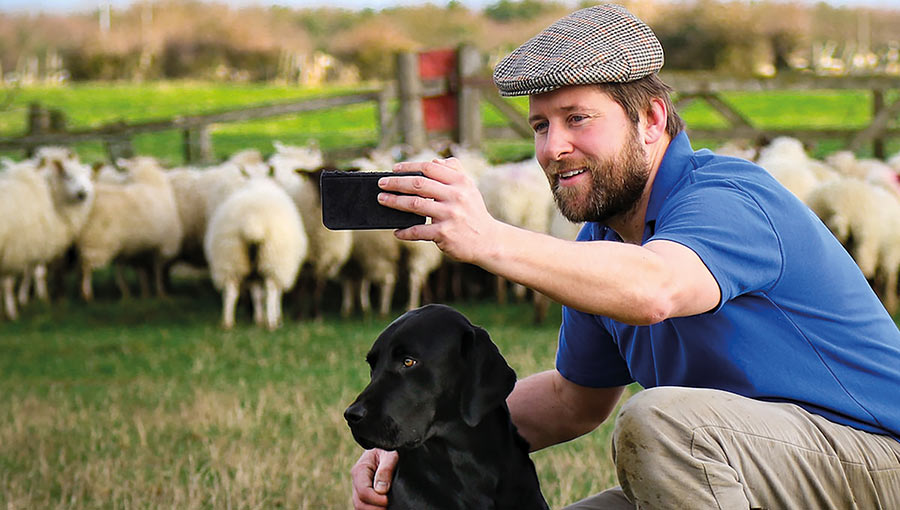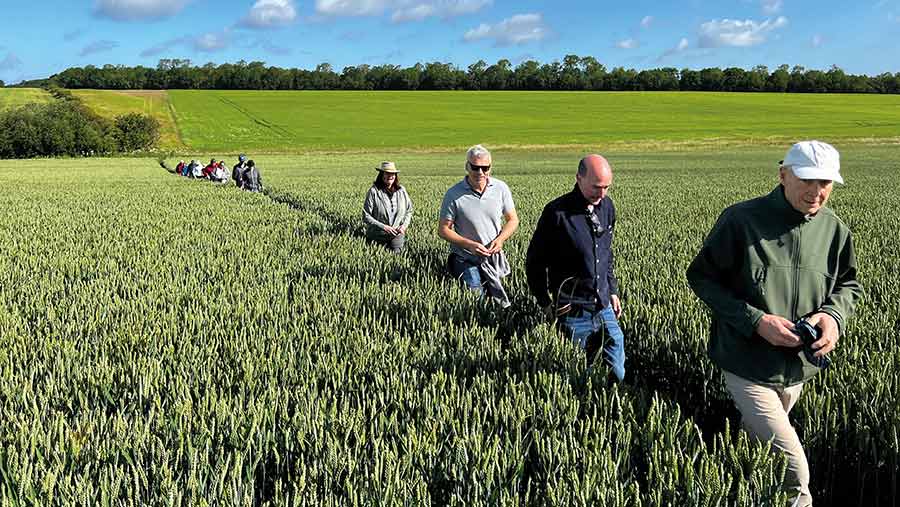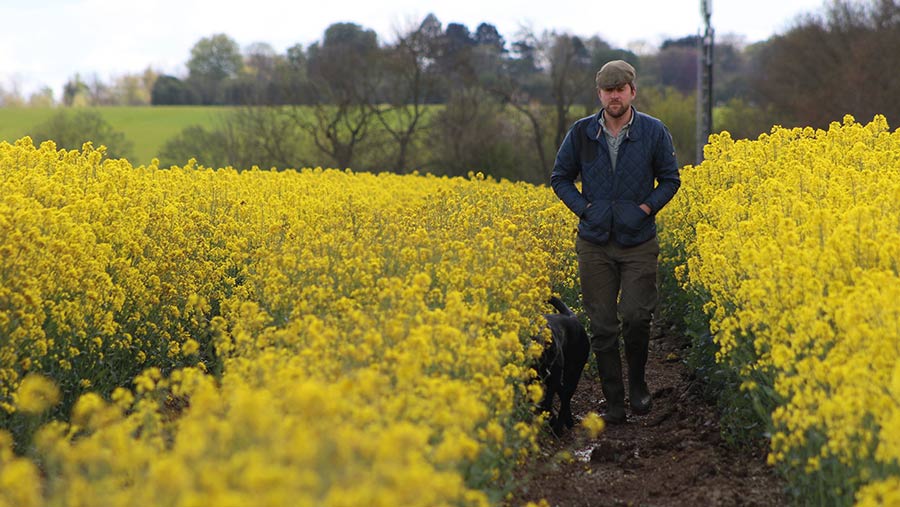How film career skills help ‘Farmer Tom’ promote British ag
 Tom Martin making a FarmerTime call © Lisa Miosi Photography
Tom Martin making a FarmerTime call © Lisa Miosi Photography A career in the film industry is not the typical entrée to the world of agriculture, but for Cambridgeshire arable and regenerative farmer Tom Martin, aka Farmer Tom, this was his exact path.
After 10 successful years working in film distribution for Universal Pictures, and with previous experience in business strategy and consultancy, Mr Martin decided it was time to return to the family arable farm and give farming a go.
See also: The benefits of integrating trees into productive arable land
He is now applying knowledge gained from his previous career to promote British agriculture and share his farming journey.
“I left university and became a consultant and analyst,” he says.
“Then I worked in news and magazine distribution, before working in licensing at Universal Pictures.
“But growing up on farm in north-west Cambridgeshire, I always loved the countryside, so I thought one day I would come back to farm.”
Transfer of skills
Since returning to Village Farm in Haddon, Mr Martin has applied his wealth of business, marketing and communication knowledge to the farm, which grows wheat, barley, rapeseed, linseed and beans.
“There’s certainly a range of transferable ‘soft skills’ which you learn in all kinds of careers that can be taken from business to business, and this includes agriculture,” he says.
During his early career, Mr Martin recalls spending a lot of time in marketing meetings discussing customer engagement and product branding.
This got him thinking how he could apply this to the world of farming – particularly connecting people with their food.
As a farmer, grower and seller, his first port of call was to market himself in a way that would be engaging to members of the public.
From this came the name Farmer Tom, which has proved successful on social media, where he shares regular farming content with more than 17,000 followers on Twitter and 11,000 on Facebook.
Farmer Time
Next, he wanted to portray the passion of farming people to the general public, connecting them with those who produce their food.
His background in film and public speaking produced his next idea: Farmer Time, which has proved a great success in promoting British agriculture in UK schools.
The Farmer Time initiative (formerly called FaceTime a Farmer) is a video call between one farmer and their matched classroom, which typically lasts 10-15 minutes every two or three weeks.
It currently connects 20,000 schoolchildren each fortnight with their own UK farmer – 800 farmers are signed-up, each with their own dedicated class.
“School teachers typically e-mail the farmer ahead of the scheduled call, detailing what the students have been recently studying.
“Whether it’s soils, the natural environment or genetics, this can provide a potential talking point for farmers,” says Mr Martin.
“We currently have more demand from schools than we have farmers signed-up, so we are always looking for more farmers to join.”
Walk the Farming Year
Having virtually showcased his farm, he also wanted to welcome people face to face. This prompted him to sign up for Open Farm Sunday, which attracted a range of locals of all ages.
However, he soon realised that opening the farm for just one day a year gave the public only a limited snapshot of what life on the farm was really like.
From this, he came up with a small diversification business called Walk the Farming Year, which enables members of the public to come on to the farm for eight guided walking tours throughout the calendar year, in return for a small fee.
He talks them through the farm’s cropping rotation, the use of various bits of machinery and details of some of the agronomy.

A Walk the Farming Year tour © Lisa Miosi Photography
“We are now in our second year and currently have a group of 15 people, consisting of wildlife enthusiasts, local villagers and agronomists who are all interested in agriculture and rural life.
“It is a real opportunity to bring people on farm and explain first-hand what farming life is all about, while also generating an income,” he says.
Another initiative Mr Martin and his wife Lisa created is a small community garden, which enables a number of locals to work together and get involved with producing home-grown produce.
Public speaking and overseas ambassador
Mr Martin is also a keen public speaker, giving a variety of talks to farming groups which include AHDB Monitor Farm meetings and Groundswell discussions. One of his latest talks involved a trip to Norway.
“I had the absolute pleasure of sharing my farming journey, mistakes and successes, with 150 Norwegian farmers and ag professionals interested in regenerative farming.
“I love the culture of being open, accepting mistakes, and learning from them and sharing this with others. It is so refreshing,” he says.
Farming journey and learning from mistakes
Eight years into his farming journey Cambridgeshire farmer Tom Martin explains how he accidentally fell into the world of regenerative agriculture.
“I’ve never been ‘on trend’ with anything, but regen ag makes sense for us,” he says.
“It’s all about doing what’s right for you and using the tools available to help you achieve your aims in a flexible way.
“This is why we’re aiming to make our soils more resilient. We cannot change the weather but we can adapt our farming systems to tolerate this better.”
The five regenerative principles that fit well with his farming system and are as follows:
- Keep the soil surface covered
- Minimal soil disturbance
- Keeping roots in the soil
- Integrate grazing livestock
- Increase biodiversity
Companion crops in OSR
For 15 years the farm operated a min-till system and has since slowly moved to direct drilling.
The use of a Sky Easydrill allows him to drill rapeseed and a companion crop mix, and apply di-ammonium phosphate simultaneously. “We’ve essentially merged five operations in just one pass,” he says.
Buckwheat, berseem clover and fenugreek (a herb commonly used to flavour curries) are planted as a companion mix alongside rapeseed to mitigate cabbage stem flea beetle attacks.
“The buckwheat grows quickly to cover the ground, while the fenugreek masks the smell to disguise the OSR,” he explains. “We aim to drill as early as possible, in July if possible.”

© Lisa Miosi Photography
The pest has proved a big issue for the farm, but a combination of healthy soils, companion crops and silica sprays strengthening crops has proved effective over the years.
“No insecticides are applied and a recent flea beetle pyrethroid resistance test revealed 25% of flea beetles to be resistant. We still find a flea beetle in every field, but crops are no longer damaged.”
Blackgrass remains another significant challenge, and every decision made on farm takes blackgrass into consideration.
Reducing tillage to stop the seed-bed from being disrupted and incorporating more spring crops into the mix, such as beans and linseed, is helping tackle the issue.
